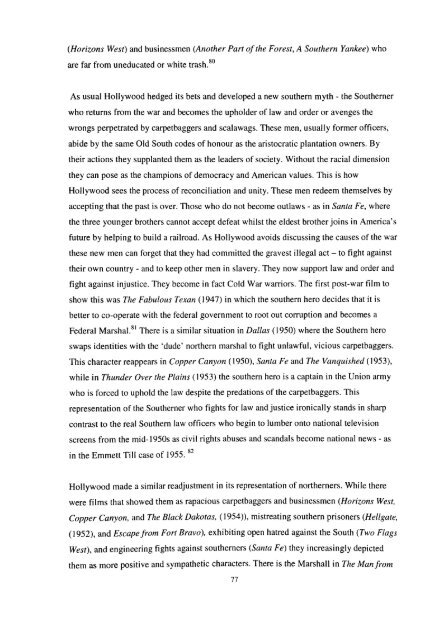Download (3483kB) - Greenwich Academic Literature Archive ...
Download (3483kB) - Greenwich Academic Literature Archive ...
Download (3483kB) - Greenwich Academic Literature Archive ...
- No tags were found...
Create successful ePaper yourself
Turn your PDF publications into a flip-book with our unique Google optimized e-Paper software.
(Horizons West) and businessmen (Another Part of the Forest, A Southern Yankee) whoare far from uneducated or white trash.0/\As usual Hollywood hedged its bets and developed a new southern myth - the Southernerwho returns from the war and becomes the upholder of law and order or avenges thewrongs perpetrated by carpetbaggers and scalawags. These men, usually former officers,abide by the same Old South codes of honour as the aristocratic plantation owners. Bytheir actions they supplanted them as the leaders of society. Without the racial dimensionthey can pose as the champions of democracy and American values. This is howHollywood sees the process of reconciliation and unity. These men redeem themselves byaccepting that the past is over. Those who do not become outlaws - as in Santa Fe, wherethe three younger brothers cannot accept defeat whilst the eldest brother joins in America'sfuture by helping to build a railroad. As Hollywood avoids discussing the causes of the warthese new men can forget that they had committed the gravest illegal act - to fight againsttheir own country - and to keep other men in slavery. They now support law and order andfight against injustice. They become in fact Cold War warriors. The first post-war film toshow this was The Fabulous Texan (1947) in which the southern hero decides that it isbetter to co-operate with the federal government to root out corruption and becomes aFederal Marshal. 81 There is a similar situation in Dallas (1950) where the Southern heroswaps identities with the 'dude' northern marshal to fight unlawful, vicious carpetbaggers.This character reappears in Copper Canyon (1950), Santa Fe and The Vanquished (1953),while in Thunder Over the Plains (1953) the southern hero is a captain in the Union armywho is forced to uphold the law despite the predations of the carpetbaggers. Thisrepresentation of the Southerner who fights for law and justice ironically stands in sharpcontrast to the real Southern law officers who begin to lumber onto national televisionscreens from the mid-1950s as civil rights abuses and scandals become national news - asin the Emmett Till case of 1955. 82Hollywood made a similar readjustment in its representation of northerners. While therewere films that showed them as rapacious carpetbaggers and businessmen (Horizons West,Copper Canyon, and The Black Dakotas, (1954)), mistreating southern prisoners (Hellgate,(1952), and Escape from Fort Bravo), exhibiting open hatred against the South (Two FlagsWest), and engineering fights against southerners (Santa Fe) they increasingly depictedthem as more positive and sympathetic characters. There is the Marshall in The Man from77
















